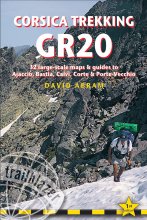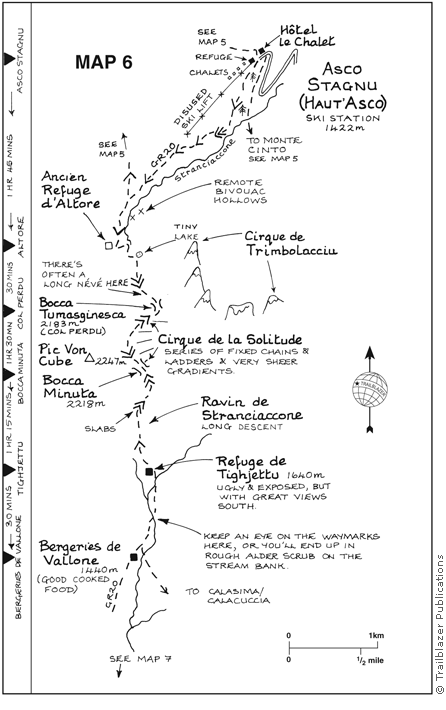'Fantastically detailed and well-presented.'
— Backpack magazine

Corsica Trekking GR20
Excerpt:
Sample route guide
Contents | Introduction | Independently or with a group? | Route options | Practical information for the visitor | Sample route guide

STAGE FOUR: ASCO STAGNU (HAUT’ ASCO) – REFUGE DE TIGHJETTU – BERGERIES DE VALLONE (MAP 6)
Overview
If one stage could be said to define the GR20 it would have to be this one.
The passes on the fourth étape may not be the highest but the terrain they enclose – namely the infamous Cirque de la Solitude – tends to linger in the memory more vividly than any other on the route.
The main reason is a series of sheer stepped pitches, negotiated by means of fixed chains and a metal ladder, which take you across the head of a steeply concave valley.
Although undeniably strenuous, the scrambling is no more difficult than that experienced on some sections of the previous three days. In fact, with the fissured profile of Paglia Orba looming above you, this has to be one of the most intensely enjoyable legs of the whole GR20.
Yet for some reason the cirque's reputation endures, a fact that probably accounts more than the actual terrain for the people-jams that form here.
At the height of the summer trekkers who are normally comfortable and quick on steep, exposed rock will find themselves held up unless they get to the cirque early in the day before the queues form.
Those of more nervous disposition should take solace in the fact that very few people fail to complete this section (not least because to avoid it you'd have to make a huge detour by road to Corte and another to Col de Verghio).
If you do get the jitters in the cirque you'll be that much more proud of yourself once it's behind you.
By comparison, the rest of the étape – comprising one long, gradual ascent (the last bit of it across a n�v�) and a somewhat steeper descent through a huge boulder field – is easy going.
Starting out from Asco Stagnu, it's not unusual for trekkers to press on to the Refuge de Ciottulu a i Mori after a leisurely lunch at the Bergeries de Vallone, one of the nicest pit-stops on the GR.
Route guide
The red-and-white waymarks lead out of Asco Stagnu along the line of the ski lift initially, bearing left towards the pine woods above.
As you progress up the valley the imposing profile of the Cirque de Trimbolacciu's peaks rise to the south through gaps in the trees. The path emerges from under the pines to open, grazed ground carpeted in juniper, with clumps of crocuses and the odd orchid dotting the grassier patches during the early summer.
The route then makes a sweeping ascent of the valley's north side, nearing the stream towards the top.
A short, steeper section up a gravelly path brings you to the site of the Ancien Refuge d'Altore, which burned down in 1982. Its remains are scattered on a balcony below the first of the day's challenges, the 30-minute climb to Bocca Tumasginesca (also called Col Perdu; 2183m).
This sheltered, north-facing slope often holds snow until well into the season. Towards the top of it you may be lucky enough to catch a glimpse of the Alps on the far horizon.
Most minds, however, tend to be on what's ahead. From the lip of the pass the ground falls away almost vertically into the upper Filosorma Valley, bounded by the imposing profile of Paglia Orba and its surrounding mantle of rock towers.
To cross the Cirque de la Solitude to reach the Bocca Minuta, the niche visible on the opposite side, you have to descend 200 metres and clamber all the way back up again.
In dry conditions proficient rock climbers will have little need of the chains whose clanking reverberates around the ravine, but these are essential aids when the granite is wet and slippery. Keep a close eye on the waymarks throughout and avoid dislodging loose rock onto people climbing below you.
With a clear run you can be across the cirque in 90 minutes or less. Once at the Bocca Minuta (2218m) a radically different landscape is revealed to the south. Visible on the horizon for the first time are the mountains of the central Corsican watershed, which you'll be crossing in the days ahead.
The descent from the pass to the rocky Ravin de Stranciaccone, across a mixture of broken boulders and giant lichen-covered slabs, is straightforward though hot work in the afternoon; it's south-facing and almost entirely shadeless.
Refuge de Tighjettu and Bergeries de Vallone
Surrounded by a vast mass of green-tinged rock, Refuge de Tighjettu is perched atop a spur between the Stranciaccone and Stagni ravines, looking south across the Vall�e de Vallone and the ridgetops of Niolu to Monte Rotondo in the distance.
Built of wood, it's an angular modern construction with beds for 45 trekkers. The bivouac area is directly below the main building. A huge range of supplies is also available from the gardien.
The size, popularity and overall ugliness of Tighjettu encourage many trekkers to continue down the valley for another half-hour to the more congenial Bergeries de Vallone, where a shepherd and his family have set up a small caf’ offering hot meals, snacks, drinks and basic accommodation.
A couple of old canvas tents provide sheltered beds (5€); you can also bivouac or camp here for 3.50€ (including the use of a flush toilet).
The food, served on their lovely wooden deck or rear terrace, is authentic and delicious (particularly the home-made charcuterie and Niolin ewe's cheese); the prices are reasonable too considering how far supplies have to be brought.
If your budget can stretch to it go for the full 18€ four-course menu, which might include wild-boar stew or an omelette made with fresh mint and brocciu, rounded off with melt-in-the-mouth fiadone.
Latest tweets